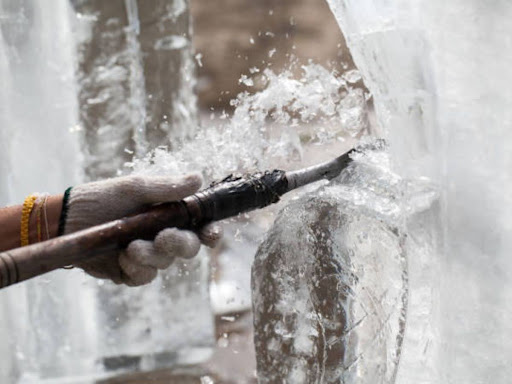Ice sculpting is an art form that merges creativity, precision, and craftsmanship in a way few other mediums can. From ornate centerpieces at weddings to grand displays at winter festivals, ice sculptures captivate audiences with their elegance and temporary beauty. But behind every jaw-dropping sculpture lies a skilled artisan and a carefully selected set of tools. Whether you’re a beginner looking to dip your toes into the world of ice carving or an experienced sculptor wanting to refine your craft, understanding the different ice sculpture carving tools is essential.
This guide will walk you through the various types, uses, and benefits of the tools that bring frozen visions to life.
The Importance of the Right Tools in Ice Sculpting
Before diving into the types of tools, it’s crucial to understand why choosing the right ones matters. Ice sculpting demands not just artistic vision but also technical accuracy. Unlike stone or wood, ice is fragile and time-sensitive. It reacts quickly to temperature, light, and touch, making it essential for sculptors to use tools that minimize damage while maximizing precision.
Having a specialized set of ice sculpture carving tools ensures smoother cuts, better detailing, and less risk of cracking or shattering. Moreover, the right tools can greatly enhance your workflow, making the process both efficient and enjoyable.
Types of Ice Sculpture Carving Tools
Let’s explore the most commonly used ice carving tools, their applications, and what makes them essential for both novice and professional sculptors.
1. Chainsaws
Chainsaws are often the first tool used when working with large blocks of ice. These powerful tools are ideal for making the initial cuts and shaping the rough outline of the sculpture. Specialized chainsaws for ice work at high speeds and are often equipped with non-toxic, food-grade lubricants to ensure cleanliness.
While chainsaws may seem intimidating, they are indispensable for speed and efficiency, especially in outdoor exhibitions or time-sensitive competitions.
2. Chisels and Gouges
Chisels are the backbone of detailing work in ice sculpting. They come in various sizes and shapes, including flat, V-shaped, and U-shaped blades. These tools are perfect for refining features, adding textures, and carving intricate patterns.
Gouges, which have curved edges, are used to scoop and smooth out surfaces. Both tools require a strong, ergonomic handle for precision and comfort during extended sessions.
3. Hand Saws and Ice Picks
For more controlled cuts, hand saws are useful. They’re smaller than chainsaws and allow for cleaner, more deliberate shaping. Ice picks, on the other hand, are ideal for breaking off small pieces or adding fine details. These tools are essential for moments when finesse is more important than force.
4. Grinders and Sanders
For smoothing surfaces and adding polished finishes, electric grinders and sanders come into play. These tools help in refining edges and creating reflective surfaces that enhance the sculpture’s appearance under lighting.
Interestingly, some artists adapt power carving tools for wood for use in ice sculpting. These tools, such as rotary grinders and micro carvers, can be very effective when used correctly and with care. The key is ensuring that any tool used on ice remains clean, sharp, and resistant to moisture.
Specialized Ice Carving Tools
While many tools overlap with those used in wood or stone carving, there are unique tools designed specifically for ice:
- Ice Tongs: For lifting and moving large blocks.
- Ice Planers: Used to level the surface of the ice or create specific angles.
- V-Notch Tools: Help in etching straight lines or grid patterns.
Each of these specialized ice carving tools plays a crucial role depending on the design complexity and the sculptor’s preferred technique.
Safety Considerations
Handling ice sculpture carving tools—especially powered ones—requires strict adherence to safety protocols. Ice is slippery, heavy, and fragile, so protective gear like gloves, goggles, and non-slip boots is a must. Also, temperature-controlled environments or shaded areas should be used to slow down melting during the carving process.
Maintaining your tools is equally important. Rust, dull blades, and moisture build-up can not only hinder your work but also pose safety risks.
From Hobbyist to Professional
Whether you’re starting out as a hobbyist or working toward professional exhibitions, investing in a reliable set of ice carving tools is key. It’s also wise to observe experienced sculptors at work or even attend workshops. These opportunities offer hands-on experience with tools and techniques that online tutorials alone may not fully convey.
Remember, tools that work for wood may serve as a starting point, but specialized ice tools are built with unique features like anti-rust coatings and thermal resilience. So while some may experiment with power carving tools for wood, nothing quite replaces the efficiency and reliability of gear specifically designed for ice.
Conclusion
Ice sculpting is a breathtaking blend of art and technique, and at its heart lies the need for precision tools. Understanding and investing in the right ice sculpture carving tools can significantly impact the quality, safety, and enjoyment of your sculpting journey. From chainsaws to chisels, each tool plays a vital role in transforming a solid block of ice into a masterpiece.


